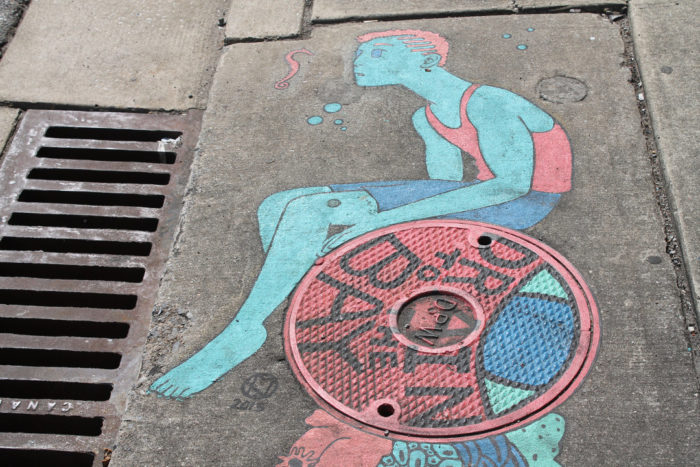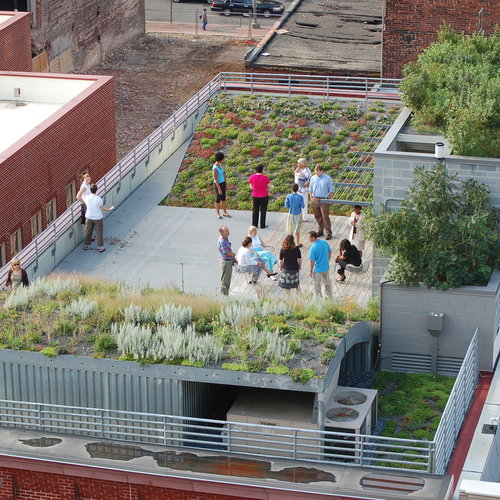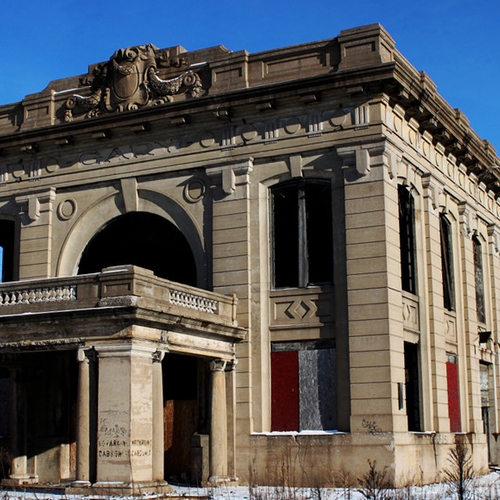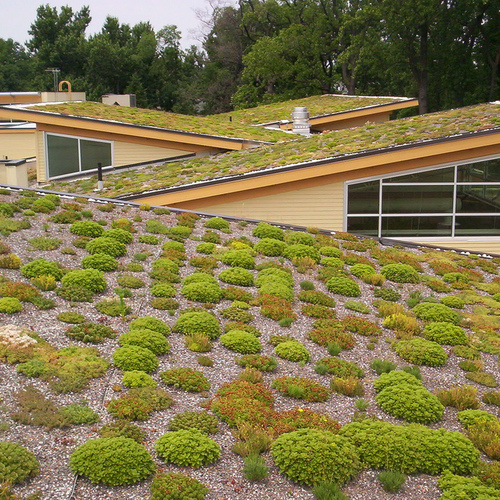Image Credit: Elvert Barnes / CC BY-SA 2.0 / Flickr
Image Credit: Elvert Barnes / CC BY-SA 2.0 / Flickr Like many U.S. cities, Stillwater, Minnesota, consists of a relatively small urban core near a river surrounded by low-density development. (Image: Madeline Goldkamp)
By THOMAS FISHER and MADELINE GOLDKAMP
Natural assets — “green infrastructure” — can provide communities with invaluable ecosystem services that clean our air, filter our water, mitigate natural disasters, and improve our quality of life.
The Trump administration has called for a major investment in infrastructure. That includes systems that handle our rainfall and melted snow, such as stormwater management systems, water filtration plants, and roadway curbs and gutters.
Offering an alluring alternative to this traditional “gray infrastructure,” green infrastructure handles rainfall runoff through vegetated buffer strips around surface water, forested habitat corridors, and regenerated wetlands, among other options. But how do we pay for it?
Our research team has explored one way that communities can cut costs and promote better infrastructure: Let property owners buy and sell credits based on their stormwater runoff. We have also used this approach to encourage a partnership between urban and rural communities. By funding the latter to take some land out of agriculture production, we can protect valuable surface water and animal habitat.
Stormwater credits
Our work has tried to solve two problems that have rarely been thought of as related: the growing amount of impervious surfaces in urban and suburban areas, and the growing pressure to protect freshwater in rural areas.
The U.S. has 4,360 square miles of surface parking lots. These lots generate a great deal of runoff that stresses the stormwater systems of cities and cause considerable water pollution.
Communities sometimes require property owners to handle some of that runoff on site, in wetlands or retention ponds. But cities — especially those with a lot of low-density commercial development — can find it difficult to cover the cost of extensive stormwater sewer systems.
And yet, especially in fully built-out cities, there may not be enough land for green infrastructure to handle all of the surface runoff from commercial properties. But rural areas have that kind of land in abundance.
Linking the rural supply of land and the urban demand for it can help protect valuable freshwater resources without depending upon government funding. It creates a regional marketplace that can transfer funds from more affluent urban communities to less affluent rural ones.
This opportunity is particularly pertinent to any community with agricultural land near urban or suburban areas with a lot of impervious surfaces, such as parking lots or large flat roofs. That characterizes more than 90% of the 19,492 cities in the U.S.
Like selling carbon credits, rural property owners could sell stormwater retention credits to urban landowners to offset stormwater impacts downstream. The sale of those credits would relieve commercial landowners in cities and suburbs from having to handle all of their stormwater on site. At the same time, it would pay farmers to take land out of agricultural production and convert portions of it back to green infrastructure.
In 2013, the Department of Energy and Environment in Washington, D.C., launched the Stormwater Retention Credit Trading Program. This program, the first of its kind in the country, aimed to offset the costly expansion and maintenance of gray stormwater infrastructure. The program encourages new developments to surpass their stormwater retention requirements. That allows them to sell Stormwater Retention Credits (SRC) to older developments that cannot retain all of their stormwater on site.
The District of Columbia charges property owners an annual fee, based on the gallons of stormwater runoff from a property. Owners must mitigate at least half of their runoff on site, if technically feasible. They can account for the other half by either paying a fee per gallon per year or purchasing credits from another site. One credit corresponds to the retention of one gallon of stormwater for one year.
The program has been underway for a relatively short period of time. But it has already generated SRC swaps within the district, helping a less affluent community, Anacostia, reduce polluted runoff into the Anacostia River and generate funds for two community organizations. Other case studies documenting the impact of the program are underway.
How it would work in Stillwater, Minnesota
We think that this type of program offers a viable way to stimulate green infrastructure in communities large and small across the U.S. To test that assumption, let’s look at how stormwater retention credits might work in a typical small town – in this case, Stillwater, Minnesota.
Like many American communities, Stillwater has a relatively small urban core oriented toward a river. It has commercial development along major highways and a ring of sprawling low-density suburban development surrounded by agricultural land (see the map reproduced as Image #2, below). The greatest amount of Stillwater’s impervious surfaces are in commercial areas, the downtown district, industrial zones, and road and highway right-of-ways.
Minnesota’s legislature has had heated debates over a bill, signed into law in 2015 and twice amended since then, that requires the installation of landscape buffer strips around major bodies of water. This law has pitted environmentalists against farmers. Environmentalists want to protect water quality in the state, while farmers argue that the law puts an undue burden on them by taking land out of production with no compensation.
Both sides have a point. In the D.C. program, we saw an opportunity both to protect water quality and to compensate farmers and other property owners for installing buffer strips.
For purposes of this study, we focused just on a commercial area at the edge of town, with several large big-box stores facing a highway. In Stillwater, that commercial area covers 237 acres, 64% of which is impervious. That translates to approximately five million gallons of stormwater runoff during a 1.1-inch stormwater event. Such an event has a 90% likelihood of occurring in any given year in a state like Minnesota.
By charging just 50 cents per gallon per year — far less than what D.C. charges — Stillwater could generate approximately $1.2 million or the equivalent in SRC credits. With the value of one acre of farmland set to 500 SRCs or $100/acre/year, this creates a positive cash flow to farmers whose land in production generates, on average, just $79/acre/year.
In Stillwater, where the watershed has 99 lakes and 24 miles of streams, this translates to 4,706 acres of potential land for green infrastructure. Implementing 100-foot buffer zones around these water bodies leaves 2,441 acres of land available for conversion to green infrastructure in other portions of the landscape, such as along rural roads, in order to handle runoff from farm fields.
What about your city?
Green infrastructure offers an economically viable, politically equitable and environmentally responsible way of dealing with our nation’s landscape. A stormwater retention credit trading program represents a cost-effective solution to dealing with America’s aging infrastructure. It protects local watersheds, lowers costs for urban and suburban property owners, and increases payments to farmers, while protecting our waterways and providing habitat corridors for other species. That’s a win-win-win for everyone involved.
If widely adopted, such a program could transform the way in which we think of infrastructure and make our nation’s infrastructure investment go much farther by utilizing the marketplace to expand its impact and reach.
A credit trading program can also work in areas beyond that of stormwater, such as renewable energy, where rural areas have an ample supply of solar and wind access, and urban areas have a growing demand for green energy. Market mechanisms, in other words, may be one of the most effective ways to address some of the economic inequities, political divisions and infrastructure needs that have plagued the U.S.
Thomas Fisher is a professor of architecture and director of the Metropolitan Design Center at the University of Minnesota. Madeline Goldkamp is a graduate student of landscape architecture at the University of Minnesota. This post originally appeared at The Conversation.
Weekly Newsletter
Get building science and energy efficiency advice, plus special offers, in your inbox.















5 Comments
Math?
At fifty cents per gallon, five million gallons would cost $2,500,000 just for one 1.1" storm, or in the vicinity of $ 100,000,000 per year, assuming 40" in annual precipitation .
And $100 per acre of farmland? Am I missing something?
That's $100 SRC-acre
That's $100 SR- credit-acre, contracts to restrict that land from being paved and to retain storm water, not a purchase & sales price to own or rent the real estate.
The 50 cents/gallon isn't for the total annual rainfall, only for high-volume single storm events exceeding an inch in one go. Annual rainfall of 40" per year is only ~0.11"/day. But the retention is only useful or needed for those single day events exceeding ~10x the average rate.
Bear with me
I'm a bit slow understanding these things. The projects I've been involved with where on-site storm water retention was required did so to not overwhelm the municipal or local storm water systems. They allowed a slower rate of release during storm events, and in one case pumped out the holding tanks based on volume in the nearby storm system.
Doesn't there have to be a physical link between the areas generating the storm water and the rural areas able to take it? How does just linking them through financial credits help? I see how paying rural areas to maintain their natural state may seem appealing, but the link seems a bit tenuous. Why make urban paved areas pay for this over any other group? Why not highway users? Polluters? Why anybody?
Watersheds - Rural & Urban Coupling
Malcolm, I read the premise to be that credits would be exchanged within the same watershed.
For example here in the east we have a significant problem with water quality in the Chesapeake Bay; one of the barriers, or lack thereof, is that a dam on the Susquehanna River before the bay is now full of sediment.
http://www.chesapeakebay.net/issues/conowingo_dam
Reducing storm water flows anywhere in the watershed deceases peak magnitude and velocity of the water in the streams and rivers that ultimately feed into the Susquehanna. This allows sediment to be dropped earlier in that watershed, and also prevents it from being scoured later in that same watershed.
All gallons of water end up at the same destination. One gallon of water captured on my farm is one less gallon of water over the Conowingo dam hundreds of miles away.
Dana
Even 50¢ for every gallon in storms exceeding an inch is a pile of money. And I realize that the $100 per acre is just for the benefit of the land soaking up rainfall. But that's also a pile of money.
The concept is fine, but the idea that a developer would or could pay those kinds of fees is unrealistic.
Log in or create an account to post a comment.
Sign up Log in